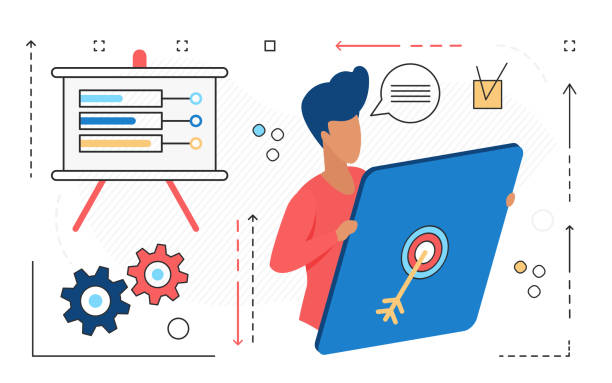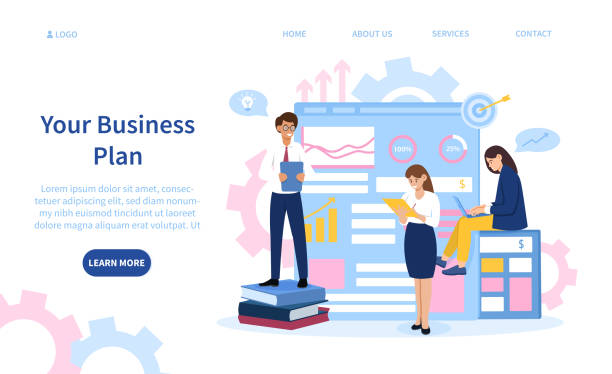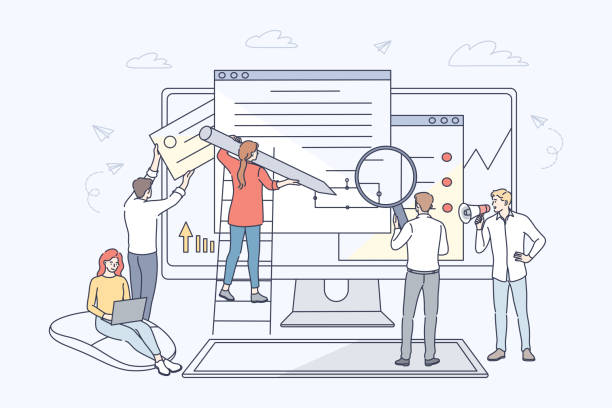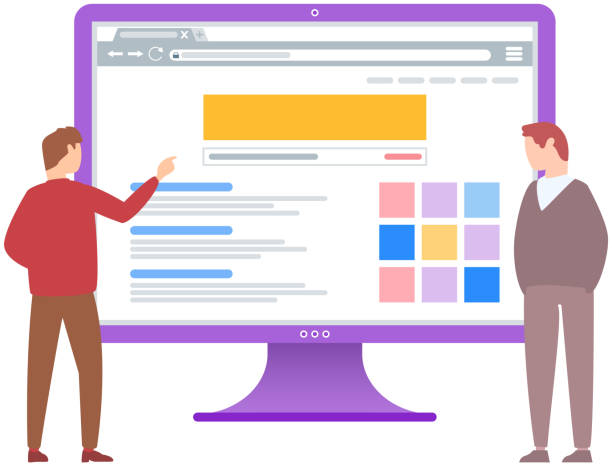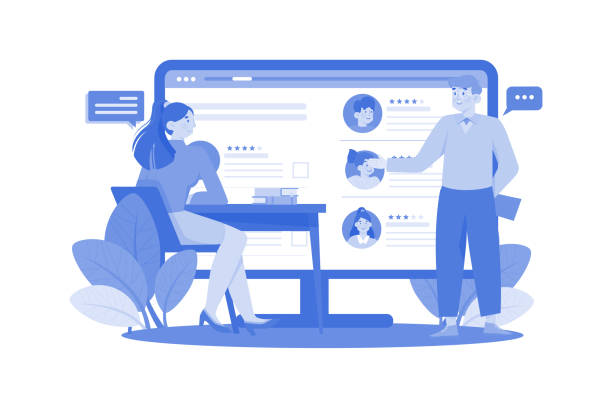Introduction and Necessity of Multilingual Website Design
In today’s digital world, where geographical boundaries have lost their former meaning, access to global markets has become more important than ever.
#Multilingual_website_design is no longer a competitive advantage, but a strategic necessity for any business aiming to operate beyond its local borders.
This approach allows you to connect with a wider audience from diverse cultures and languages.
In fact, a single-language website is like a door that opens only to a specific group, whereas multilingual website design opens multiple doors to international markets.
This not only helps increase your website’s traffic but also strengthens your brand’s image as a global and inclusive entity.
Many studies have shown that users prefer to visit websites whose content is provided in their native language.
This is particularly crucial in online purchasing processes and attracting international customers.
Imagine having a website that, in addition to Persian, offers its content in English, Arabic, Chinese, or Spanish; this means access to billions more potential users.
Therefore, for any business seeking sustainable growth and development on a global scale, investing in multilingual website design is considered a wise and vital decision.
This process goes beyond mere text translation; it includes understanding cultural nuances and localizing content for each target market, which we will cover in subsequent chapters.
This is an essential step towards creating a powerful and impactful presence on the global stage.
Does your current website showcase your brand’s credibility as it should? Or does it scare away potential customers?
RasaWeb, with years of experience in professional corporate website design, is your comprehensive solution.
✅ A modern, beautiful website tailored to your brand identity
✅ Significant increase in lead and new customer acquisition
⚡ Contact RasaWeb now for a free consultation on corporate website design!
Competitive Advantages of Multilingual Websites
Multilingual website design is more than just a communication tool; it is a strategic trump card in the global competitive battle.
One of its most prominent advantages is the significant expansion of audience reach.
By providing content in various languages, your business can directly connect with customers worldwide who were previously difficult to access.
This translates to increased website traffic, improved conversion rates, and ultimately, growth in sales and revenue.
Furthermore, multilingual websites significantly enhance a brand’s credibility and professionalism.
When a company is willing to put in the effort to provide information in its customers’ native language, it demonstrates respect and commitment to customer service, which strengthens trust and loyalty.
In the field of search engine optimization (SEO), multilingual websites have a significant competitive advantage.
Search engines index multilingual websites for keywords in different languages, which means a greater chance of higher rankings in international search results.
This, in turn, increases organic traffic and brand discoverability.
Moreover, entering new markets through multilingual website design provides unique opportunities for business expansion.
These sites allow companies to offer their products and services to audiences that their competitors may not have yet entered.
This pioneering can lead to significant market share and a stronger position.
Finally, by increasing customer satisfaction through providing information in their preferred language, customer retention rates increase, and long-term relationships with customers are formed.
These multiple benefits make multilingual website design an essential investment for any forward-thinking business.
Challenges and Solutions for Implementing Multilingual Website Design
Implementing multilingual website design, despite its numerous advantages, also comes with challenges that require careful planning and smart solutions.
One of the biggest challenges is content translation and localization.
Mere word-for-word translation is not enough; the content must be adapted to the culture and linguistic nuances of each target region.
This includes translating idioms, units of measurement, dates, and even colors and images to prevent misunderstandings and convey a native feel to the user.
Another challenge is technical website management.
Choosing the appropriate URL structure (subdirectory, subdomain, or dedicated domain), correctly using hreflang tags for international SEO, and ensuring proper functioning of scripts and formatting in different languages are of paramount importance.
These aspects require specialized knowledge in multilingual website development.
The next issue is content maintenance and updates.
With the addition of each new language, the workload for keeping information up-to-date across all versions increases.
This requires a robust Content Management System (CMS) that supports multilingual capabilities and simplifies the process of adding and updating content.
Furthermore, initial and ongoing maintenance costs can also be a challenge, as quality translation and technical development of multilingual website design require investment.
However, the long-term return on investment usually justifies these costs.
The table below refers to some common challenges and their solutions:
| Challenge | Solution |
|---|---|
| Content Translation and Localization | Use native and specialized translators, invest in cultural localization, not just literal translation. |
| Technical Management and URL Structure | Select a suitable CMS with multilingual capabilities, correctly implement hreflang tags, consult with an international SEO specialist. |
| Ongoing Maintenance and Updates | Create a regular content update schedule, use translation management tools, hire a multilingual content management team. |
| Initial and Ongoing Costs | Careful budget planning, evaluating long-term ROI, prioritizing languages based on target market. |
Choosing the Best Strategy for Website Multilingualism
When proceeding with multilingual website design, one of the most important decisions is choosing the right strategy for hosting different language versions.
Each of these strategies has its own advantages and disadvantages in terms of SEO, management, and user experience.
The three main approaches include using subdirectories, subdomains, and country-code top-level domains (ccTLDs).
Choosing any of these options can directly impact how your website performs in search engines and the user experience in target markets.
Click here to preview your posts with PRO themes ››
Subdirectories like `yourwebsite.com/en/` or `yourwebsite.com/fr/` are generally preferred for SEO, as they inherit the authority of the main domain and are easier to manage.
All languages are located under a single domain, which helps improve the overall website’s credibility and ranking.
This method is often recommended for businesses that want to leverage their main domain’s authority for all language versions.
Subdomains like `en.yourwebsite.com` or `fr.yourwebsite.com` allow search engines to treat each subdomain as a somewhat independent entity.
This option is suitable for large organizations or websites with significantly different content in each language, but it may require separate SEO efforts for each subdomain.
Finally, country-code top-level domains (ccTLDs) like `yourwebsite.de` for Germany or `yourwebsite.fr` for France send the strongest geographical signal to search engines.
This is the best option for targeting a specific country and can significantly increase the trust of local users, as it conveys a sense of localness for the website.
However, managing multiple domains can be more complex and costly, and may require separate SEO strategies for each domain.
The correct selection of this strategy in the multilingual website design phase is a crucial step for success in global markets and should be made considering business goals, available resources, and content structure.
Consulting with international SEO specialists at this stage is highly recommended.
Do you have an e-commerce site, but your sales aren’t as expected? RasaWeb solves your problem forever with professional e-commerce website design!
✅ Significant increase in conversion rates and sales
✅ Unparalleled user experience for your customers
⚡ Click here for a free consultation with RasaWeb!
Search Engine Optimization (SEO) in Multilingual Websites
Search Engine Optimization (SEO) holds special importance in the multilingual website design process, as it ensures that different versions of your website are found by search engines for the appropriate audiences worldwide.
This goes beyond merely translating keywords and requires a comprehensive strategy for technical and content management.
One of the most crucial tools in multilingual SEO is the correct use of the hreflang tag.
These tags inform search engines, such as Google, which version of a page is intended for which language and geographical region.
Incorrect use or neglect of these tags can lead to duplicate content issues and lower your website’s ranking in search results.
In addition to hreflang, local keyword research is of vital importance.
Keywords must not only be translated but also match the phrases that local people use in their searches.
This may mean using completely different terms and phrases in different languages.
The appropriate URL structure also plays a key role; as mentioned in the previous chapter, the choice between subdirectories, subdomains, or ccTLDs should be made considering SEO goals.
Website loading speed (Page Speed) is also important on an international scale, as users in different regions may have access to the internet at varying speeds.
Optimizing images, compressing codes, and using Content Delivery Networks (CDNs) are essential for all language versions.
Finally, local link-building and establishing connections with reputable websites in each target country can help increase your website’s credibility in that region and improve SEO rankings.
Success in multilingual website design would not be possible without a strong and precise SEO strategy.
Content and Translation Management in Multilingual Platforms
Content and translation management in the multilingual website design process is the backbone of your website’s success and sustainability.
This section includes not only the initial translation of content but also the processes of maintaining, updating, and adding new content in all languages.
Choosing a suitable Content Management System (CMS) that supports multilingual capabilities is the first critical step.
Systems like WordPress with plugins such as WPML or more specialized platforms like Drupal or Optimizely (EpiServer) offer powerful tools for simultaneously managing content in different languages.
The translation process must go beyond machine translation.
While machine translation tools can be a good starting point, achieving high quality and cultural localization requires hiring professional translators and cultural localizers.
These individuals are capable of understanding linguistic nuances, local idioms, and cultural differences, and adapting the content to be completely natural and appealing to the target audience.
Additionally, creating a Glossary and Translation Memory can help maintain terminology consistency and reduce translation costs in the long run.
After the initial translation, review and quality control of the translated content are crucial.
This process should be carried out by a native speaker with full command of the target language and culture to ensure the accuracy and appeal of the content.
Furthermore, creating a content calendar that includes planning for updates and adding new content in all languages helps maintain the website’s order and dynamism.
Proper content and translation management ensures your effective and continuous communication with global audiences and adds real value to your multilingual website.
This specialized and systematic approach in multilingual website design provides a positive user experience for all visitors.
User Experience (UX) in Multilingual Website Design
User Experience (UX) in multilingual website design goes beyond mere text translation; it involves a deep understanding of cultural differences, visual preferences, and user behavior patterns in various parts of the world.
A successful multilingual website is one that not only provides content in the appropriate language but also adapts itself to the cultural expectations of local users.
For example, visual design, the use of colors, images, and even text reading direction (right-to-left or left-to-right) must align with the audience’s culture.
Overlooking these nuances can lead to misunderstandings and create a negative user experience.
Click here to preview your posts with PRO themes ››
One of the key aspects of UX in multilingual sites is the ease of language selection.
The language switcher should be clearly visible and accessible, preferably in the website’s header or footer.
Using flags alone to indicate languages is not recommended, as it might cause misinterpretation or not represent all speakers of a language; it’s better to use the full language name (e.g., “Persian” instead of a flag) for clarity.
Forms and data input fields should also be designed to comply with each country’s standards (such as date format, phone number, address).
Additionally, symbols and icons should be universally understandable to convey similar meanings across different cultures.
User testing with native users in each target region is a crucial step to identify and resolve UX issues before the full website launch.
This approach ensures that your website is not only linguistically but also culturally appealing and efficient, providing an optimal user experience for all visitors.
These aspects in multilingual website design are as important as accurate content translation.
| UX Item | Multilingual Considerations |
|---|---|
| Text Reading Direction (RTL/LTR) | Ensure correct support for right-to-left languages (such as Persian and Arabic) and left-to-right languages (most languages). Complete layout change if necessary. |
| Language Selection | Clear and accessible placement of the language switcher, use of language names instead of flags (due to regional diversity), maintaining user’s selected language throughout the visit. |
| Visual Design and Color Scheme | Choose colors and images considering their cultural meanings in target markets. Avoid symbols or images with negative connotations in some cultures. |
| Local Formats (Date, Currency, Address) | Ensure correct display of local formats for date, time, currency, phone number, and address in each language version. |
| Accessibility | Guarantee accessibility for all users, regardless of language or physical abilities, by adhering to international standards. |
Maintenance and Updates of Multilingual Websites
The multilingual website design process does not end with the website launch; rather, it’s just the beginning of a more complex journey: its continuous maintenance and updates.
This stage is crucial to ensure that the website remains active, up-to-date, and relevant for all global users.
One important aspect is managing translations and new content.
Whenever new content is added in the primary language (such as blog articles, product information, or company news), it must be quickly translated and localized for all other languages.
This requires an organized workflow and perhaps the use of Translation Management Systems (TMS) to ensure synchronization and quality of translations.
Monitoring SEO performance across all languages is also a significant part of maintenance.
This includes checking keyword rankings, analyzing organic traffic for each language, and ensuring the correctness of hreflang tags.
Any changes in search engine algorithms or competition in local markets may require new adjustments and optimizations.
Technical and security updates should also not be forgotten.
CMS platforms, plugins, and themes require regular updates to prevent security vulnerabilities and ensure compatibility with the latest web standards.
These updates must be tested across all language versions to ensure no conflicts.
Furthermore, multilingual customer support is an integral part of maintenance; responding to users’ questions and issues in their native language significantly increases customer trust and satisfaction.
Continuous investment in maintenance and updates will ensure the dynamism and efficiency of your multilingual site in the long run and preserve the return on initial investment in multilingual website design.
Does your current website convert visitors into customers or scare them away? Solve this problem forever with professional corporate website design by RasaWeb!
✅ Building credibility and powerful branding
✅ Attracting target customers and increasing sales
⚡ Get a free consultation now!
Case Study of Multilingual Website Design Successes
There are countless successes in the field of multilingual website design, demonstrating how this approach can transform businesses.
One prominent example is large technology and e-commerce companies with a global presence.
Let’s consider an educational software company.
By offering its website in multiple languages, including English, Spanish, Chinese, and French, this company has been able to access educational markets worldwide.
They have not only translated their software into different languages but also provide training courses and customer support in these languages.
The result of this multilingual website design has been a significant increase in international registrations and user loyalty from various cultures.
Another example could be a tourism website.
A website that provides destination information, hotel bookings, and travel packages in various languages (such as German, Japanese, Arabic, and Russian) can attract tourists from different parts of the world.
This website not only translates textual content but also uses images and videos that are culturally appealing to the audience of each region.
This approach of complete localization has led to increased conversion rates and popularity of the site among international travelers.
By understanding the specific needs of each market and offering tailored solutions, these companies have been able to gain the trust and satisfaction of global customers and outperform other websites in competition.
These success stories demonstrate that multilingual website design is not just a technical project, but a powerful marketing and communication strategy that can open new doors for business growth and expansion.
These successes are the result of investment not only in translation but also in a deep understanding of cultures, SEO optimization for local markets, and providing an unparalleled user experience for every audience.
Click here to preview your posts with PRO themes ››
The Future of Web Design and the Role of Multilingualism
The future of web design is inextricably linked with the concepts of globalization and multilingualism.
With technological advancements and increased internet access worldwide, digital boundaries will become increasingly blurred.
In this landscape, multilingual website design is no longer just a good feature, but an industry standard for any digital entity seeking survival and growth in the global market.
Technologies such as artificial intelligence and machine learning will play an increasing role in this transformation.
Machine translation tools will become more advanced and intelligent, capable of producing higher-quality translations closer to human translation, making the content localization process faster and more cost-effective.
Furthermore, personalizing the user experience based on language and culture will become even more important.
Websites will be able to dynamically adjust content, offers, and even the user interface based on the user’s geographical location and preferred language, even before the user manually selects the language.
This prediction is based on user data analysis and artificial intelligence.
Website accessibility for everyone, regardless of language or physical abilities, will become a fundamental principle in design.
Also, it is expected that web design platforms and content management systems will natively embed multilingual capabilities into their core, minimizing the need for separate plugins.
This integration will make multilingual site implementation easier for businesses of all sizes.
Overall, the future of the web is moving towards a more connected and inclusive digital ecosystem where language is no longer a barrier but a bridge for global communications.
Therefore, investing in multilingual website design is an investment in the future of your business.
Frequently Asked Questions
| Number | Question | Answer |
|---|---|---|
| 1 | What is multilingual website design? | Multilingual website design means creating a website whose content is available to users in several different languages. This is usually done through a simple user interface for changing the language. |
| 2 | Why should we design a multilingual website? | Multilingual website design helps you reach a larger audience worldwide, provide a better user experience for international users, and improve your global SEO. |
| 3 | What are the main methods for implementing multilingualism on a website? | The main methods include using subdomains, subdirectories, or URL parameters for each language, as well as using completely separate domains for each language. |
| 4 | Is it better for SEO to use a subdirectory or a subdomain? | In terms of SEO, both subdirectory and subdomain methods can be effective. However, many SEO specialists prefer subdirectories due to better transfer of main domain authority. |
| 5 | What are the important points in translating multilingual website content? | Translation should be done by native translators, content should be localized in addition to translation to align with the target audience’s culture, and pure machine translation should be avoided. |
| 6 | What is the role of the hreflang tag in multilingual website SEO? | The hreflang tag helps search engines like Google display the correct linguistic and regional version of a page to the appropriate users, which also prevents duplicate content issues. |
| 7 | Can a website be made multilingual without coding? | Yes, in Content Management Systems (CMS) like WordPress, powerful plugins such as WPML or Polylang exist that enable multilingual website creation without the need for coding. |
| 8 | What are the challenges of multilingual website design? | Challenges include translation management, content localization, adherence to SEO principles for each language, technical support for different languages, and ensuring design consistency across different languages. |
| 9 | What is the difference between translation and localization? | Translation is simply rendering words from one language to another, while localization involves adapting content to the culture, customs, currency, date and time formats, and even appropriate colors for the target audience. |
| 10 | What is the best User Experience (UX) for language switching? | A clear and accessible language switcher (usually in the header or footer), using language names instead of flags (due to regional diversity), and maintaining the user’s position after language change are important UX considerations. |
And other services of RasaWeb Advertising Agency in the field of advertising:
Smart SEO: Revolutionize sales with the help of real data.
Smart Google Ads: A combination of creativity and technology for campaign management through attractive UI design.
Smart Advertorials: A professional solution for user engagement focusing on attractive UI design.
Smart Google Ads: Designed for businesses seeking customer behavior analysis through marketing automation.
Smart Direct Marketing: An effective tool for increasing sales with the help of marketing automation.
And over hundreds of other services in the field of internet advertising, advertising consultation, and organizational solutions
Internet Advertising | Advertising Strategy | Advertorial
❓ Are you looking to elevate your business in the digital world? RasaWeb Afarin, a leading digital marketing agency, with expertise in SEO, online advertising, and fast website design, paves the way for your success.
📍 Tehran, Mirdamad Street, next to Bank Markazi, Southern Kazeroon Alley, Ramin Alley No. 6




